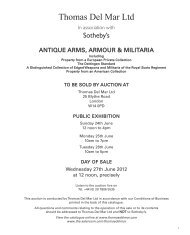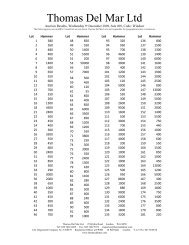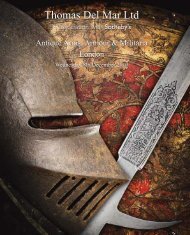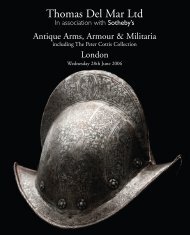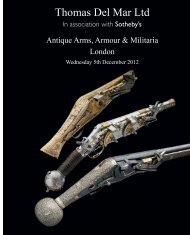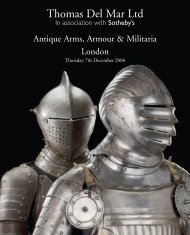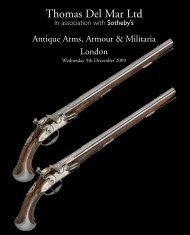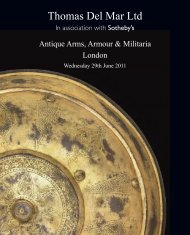Create successful ePaper yourself
Turn your PDF publications into a flip-book with our unique Google optimized e-Paper software.
258<br />
A COMPOSITE SOUTH GERMAN FLUTED HALF-ARMOUR<br />
FOR FIELD USE IN THE SO-CALLED ‘MAXIMILIAN’<br />
FASHION, CIRCA 1510-20<br />
comprising close helmet formed of a broad rounded onepiece<br />
skull with ‘bellows’ visor and bevor attached by a pair<br />
of low-domed common pivots, the visor prominently<br />
stepped beneath its centrally-divided vision-slit, pierced in<br />
three rows with ten horizontal ventilation-slots and fitted at<br />
its right side with a lifting-peg, the bevor flanged outwards<br />
at its lower edge to form a short neck-guard (slightly<br />
trimmed at its centre, the flange and left side of the bevor<br />
each showing riveted and brazed repairs) and secured to<br />
the right side of the skull by a spring-catch (push-button<br />
replaced), and one lame of a rear neck-guard (incomplete<br />
right end missing), collar of four lames front and rear (the<br />
top front lame with a later hole at the centre, the lowest<br />
front lame with a large patch at the left side, the lowest rear<br />
lame with minor chips and cracks at its main edges),<br />
breastplate formed of a rounded main plate pierced at its<br />
right side with a pair of holes for the attachment of a lancerest<br />
and fitted with moveable gussets at the arm-openings<br />
and a flanged lame at the waist, the latter restored at its<br />
outer ends with riveted patches and bearing a stud and<br />
turning-pin for the attachment of a fauld of three lames the<br />
lowest of which supports a pair of tassets each of four<br />
lames (partly reworked), backplate formed of a main plate,<br />
a pair of side-plates and a waist-lame, the latter flanged<br />
outwards to receive a culet of one lame indented at the<br />
centre of its lower edge, the upper edge of the main plate<br />
stuck with an indistinct mark, probably the quality control<br />
mark of the city of Nuremberg, spaudlers almost forming a<br />
pair, each comprised of seven lames overlapping outwards<br />
from the third (the front of the second lame of the left one<br />
repaired with a riveted internal patch) and connected by a<br />
turner to a fully articulated vambrace formed of a tubular<br />
upper and lower cannon (the lower one in each case<br />
repaired at its inside with a large riveted internal patch)<br />
each fitted at the inside of the elbow with a pair of narrow<br />
lames (the upper one of the lower cannon in each case<br />
missing) and connected by a couter of five lames<br />
112<br />
overlapping outwards from the third which is decorated on<br />
the point of the elbow with an embossed and crosshatched<br />
cinquefoil and has a small bilobate wing at the<br />
front fitted with a turning pin to secure a larger overlying<br />
detachable oval wing with a medial pucker, and gauntlets<br />
almost forming a pair, each comprised of a short straightended<br />
cuff with a hinged inner plate (the right one now<br />
held shut by a later rivet), five metacarpal-plates, a knuckleplate,<br />
five finger-plates and a hinged thumb-defence of<br />
three lames, the armour decorated overall with groups of<br />
flutes emphasised by pairs of incised lines, and at its main<br />
edges with inward turns, mainly plain but in some cases<br />
roped, and often accompanied by recessed borders<br />
(moderate pitting and wear overall, some cracks and<br />
perforations): stand not included<br />
Inv. no. A53.<br />
The helmet forming part of this armour very likely derives<br />
from a group of fluted close helmets that were deposited<br />
as booty in the Imperial Arsenal of St Irene in Istanbul,<br />
probably taken from the Knights of St John at Rhodes<br />
when they surrendered to the Ottoman Turkish forces of<br />
Suleyman the Magnificent in 1522. A high proportion of the<br />
helmets have had their neck-lames and the lower edges of<br />
their bevors removed, as in the present case. Four are still<br />
preserved in the Askeri Museum, Istanbul. See S. W. Pyhrr<br />
1989, pp. 89 & 94, figs 8 & 17. Another is preserved in the<br />
Royal <strong>Armour</strong>ies Museum, Leeds, II.14. See A. R. Dufty &<br />
W. Reid 1968, pl. XC.c.<br />
The embossed and cross-hatched cinquefoils on the points<br />
of the elbows and detachable wings on the couters of the<br />
armour described here closely resemble those preserved<br />
as part of a composite ‘Maximilian’ armour in Leeds. Very<br />
similar detachable wings can also be recorded on a pair of<br />
‘Maximilian’ vambraces formerly in the armoury of Schloss<br />
Kefermarkt, Upper Austria, and the collection of the late<br />
Stephen V. Grancsay, New York.<br />
£25000-30000



